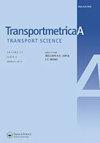影响摩托车护栏碰撞严重程度的关键因素:一种创新的聚类回归技术
IF 3.1
2区 工程技术
Q2 TRANSPORTATION
引用次数: 0
摘要
公路摩托车护栏碰撞并不常见,但会造成严重后果。在了解与这些事故有关的因素方面所做的工作很少,因此难以制定适当的缓解政策。本研究确定了高速公路上摩托车障碍碰撞的同质群体,并调查了特定群体的关键因素关联和伤害严重程度的决定因素。聚类对应分析用于发现潜在的聚类和特定的聚类关键因素的关联使用摩托车障碍碰撞从马萨诸塞州。此外,采用有序probit回归技术在聚类水平上调查因素对损伤严重程度结果的影响。确定了三个与高速公路接入控制类型相关的集群。老年人、收集者、十字路口/环形交叉路口、白天和夏季与无/部分通道控制路段撞车相关,而州际公路、坡道、中间、暗灯道路和冬季与完全通道控制路段撞车相关。影响死亡的因素在每个集群中有所不同。在此基础上,提出了提高摩托车安全性能的针对性对策。本文章由计算机程序翻译,如有差异,请以英文原文为准。
Key factors affecting motorcycle-barrier crash severity: an innovative cluster-regression technique
Highway motorcycle-barrier crashes are uncommon but are associated with severe ramifications. Little has been done to understand the factors related to these crashes, making it difficult to establish appropriate mitigation policies. This study identifies homogeneous groups of motorcycle-barrier crashes on highways and investigates cluster-specific key factor associations and the determinants of injury severity. Cluster Correspondence Analysis was employed to discover latent clusters and cluster-specific key factor associations using motorcycle-barrier crashes from Massachusetts. Further, an ordered probit regression technique was employed to investigate the effect of factors on injury severity outcomes at the cluster level. Three highway access control type-related clusters were identified. While seniors, collectors, intersections/roundabouts, daylight, and summer were associated with no/partial access-controlled segment crashes, interstates, ramps, medians, dark-lighted roads, and winter correlated with full access-controlled segment crashes. Factors influencing fatalities differed for each cluster. From the insightful findings, targeted countermeasures geared at improving motorcycle safety are suggested.
求助全文
通过发布文献求助,成功后即可免费获取论文全文。
去求助
来源期刊

Transportmetrica A-Transport Science
TRANSPORTATION SCIENCE & TECHNOLOGY-
CiteScore
8.10
自引率
12.10%
发文量
55
期刊介绍:
Transportmetrica A provides a forum for original discourse in transport science. The international journal''s focus is on the scientific approach to transport research methodology and empirical analysis of moving people and goods. Papers related to all aspects of transportation are welcome. A rigorous peer review that involves editor screening and anonymous refereeing for submitted articles facilitates quality output.
 求助内容:
求助内容: 应助结果提醒方式:
应助结果提醒方式:


